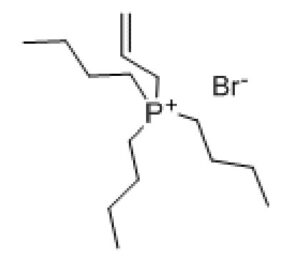
Allyltributylphosphonium bromide (CAS No: 55894-18-3) is a highly versatile organophosphorus compound used in various chemical syntheses and industrial processes. Known for its stability and reactivity, this compound serves as an important reagent and catalyst component in organic and polymer chemistry. Understanding its composition, synthesis, and applications helps researchers and manufacturers utilize it effectively across multiple fields.
Chemical Name: Allyltributylphosphonium bromide
CAS Number: 55894-18-3
Molecular Formula: C15H34BrP
Molecular Weight: 341.31 g/mol
Appearance: White to off-white crystalline powder
Solubility: Soluble in polar solvents such as water, methanol, and ethanol
Storage: Keep tightly closed in a dry and cool environment away from heat and moisture
This compound contains a phosphonium cation and a bromide anion, making it an ionic substance. The allyl group attached to the phosphonium center enhances its reactivity, making it an ideal intermediate in organic synthesis.
The compound is typically synthesized through a quaternization reaction between tributylphosphine and allyl bromide.
The general reaction proceeds as follows:
Procedure Overview:
Reactants: Tributylphosphine and allyl bromide are mixed in an inert solvent such as acetonitrile or toluene.
Reaction Conditions: The reaction is typically carried out under mild temperatures (40–60°C).
Product Formation: The resulting mixture produces Allyltributylphosphonium bromide as a crystalline solid.
Purification: The product is purified through recrystallization or solvent evaporation.
This reaction is straightforward, efficient, and yields a high-purity compound suitable for laboratory and industrial use.
Allyltributylphosphonium bromide (55894-18-3) finds application in various scientific and industrial domains due to its reactive phosphonium center and ionic properties:
Acts as a phase-transfer catalyst in organic reactions, facilitating the movement of reactants between different phases.
Used in Wittig reactions for the formation of alkenes from aldehydes and ketones.
Serves as a precursor for the synthesis of other phosphonium salts and ylides.
Plays a role in ionic polymerizations and modification of polymer backbones.
Used to introduce functional groups into polymers to enhance conductivity and thermal stability.
Used in preparing ionic liquids and functional coatings.
Contributes to developing advanced materials with tunable surface properties and electrochemical stability.
Acts as a co-catalyst or intermediate in transition-metal-catalyzed reactions, improving yields and reaction rates.
While Allyltributylphosphonium bromide is relatively stable, it should be handled with care:
Avoid inhalation and contact with skin or eyes.
Use personal protective equipment (PPE) such as gloves and goggles.
Store in a cool, dry, and well-ventilated area, away from oxidizing agents.
Always refer to the Safety Data Sheet (SDS) for detailed handling procedures and first-aid measures.
Allyltributylphosphonium bromide (CAS 55894-18-3) is a crucial compound that bridges the gap between academic research and industrial innovation. Its well-balanced combination of stability, reactivity, and versatility makes it a valuable tool in organic synthesis, polymer chemistry, and catalysis. As research progresses, this compound continues to find new applications, contributing significantly to advancements in material science and chemical engineering.